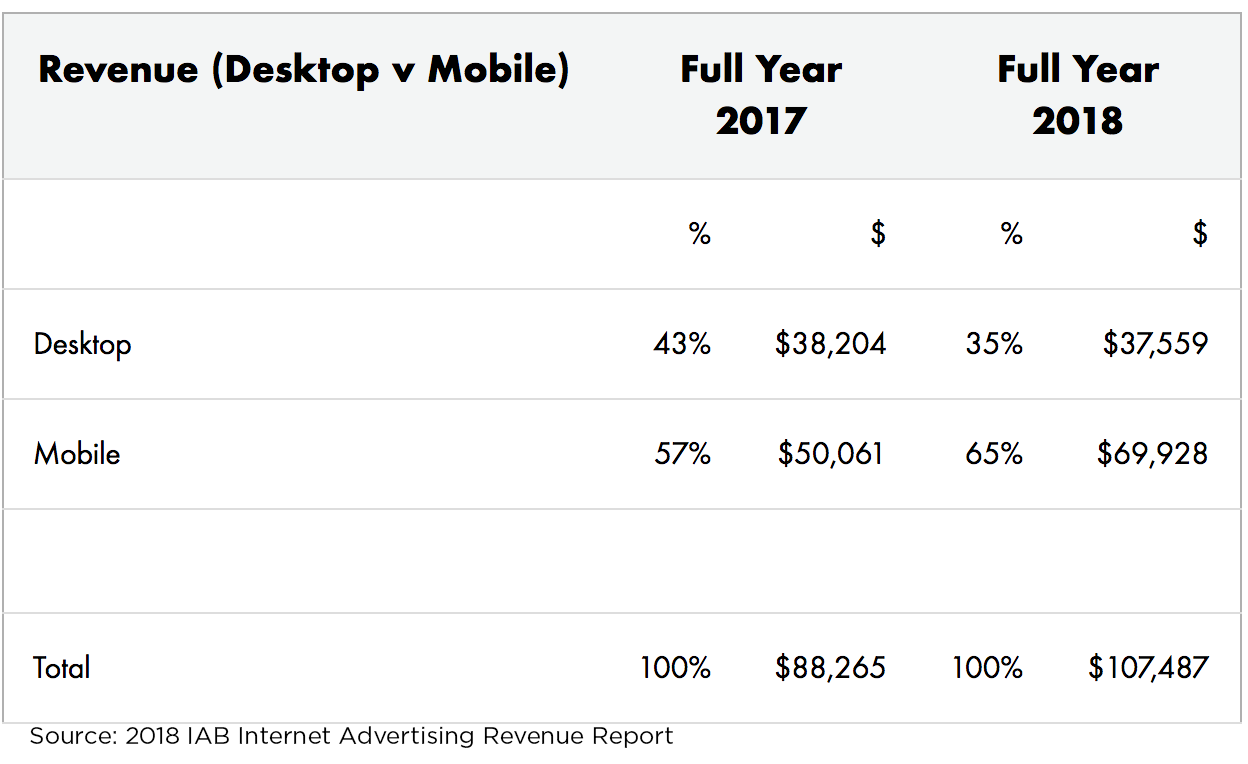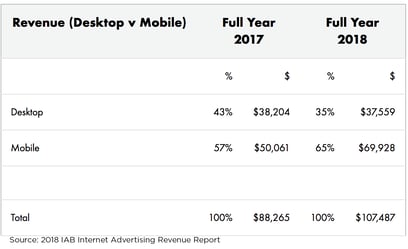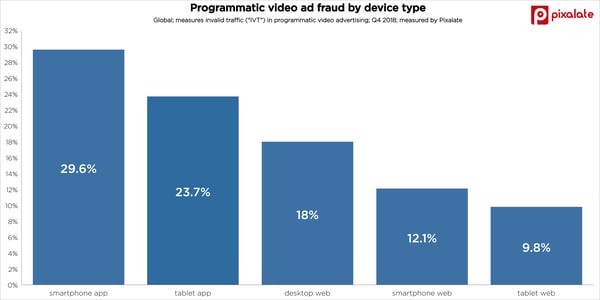
According to the 2018 IAB Internet Advertising Revenue Report, U.S. digital advertising revenues reached an all-time high of $107.5 billion — representing the first time that U.S. digital ad revenues surpassed the $100 billion milestone. This was a rise of 22% year-over-year, up from $88.3 billion in 2017.
The IAB’s ad revenue report comes at a critical time for digital advertising. According to eMarketer’s most recent report, digital now accounts for over 50% of all ad spend for the first time. However, ad fraud is still on the rise.
"Mobile and video continue to lead digital marketing’s steady growth,” wrote the IAB in its release of the report. "Accounting for nearly two-thirds (65%) of 2018’s internet ad revenues, mobile reached $69.9 billion, up 40 percent from the previous year at $50.1 billion.”
growth,” wrote the IAB in its release of the report. "Accounting for nearly two-thirds (65%) of 2018’s internet ad revenues, mobile reached $69.9 billion, up 40 percent from the previous year at $50.1 billion.”
Regarding video, the IAB wrote: "Advertising revenues from digital video saw the largest rise among all formats—an uptick of 37 percent—catapulting to $16.3 billion in 2018 from $11.9 billion in 2017.”
Given that mobile and video are individually driving growth, it’s no surprise that the combination — mobile video (e.g. watching video on mobile devices) — is also gobbling up more ad revenue.
The new IAB report notes that digital video on mobile devices eclipsed $10 billion in revenue last year, representing a rise of 65% year-over-year.
Per the report, nearly two-thirds (63%) of all digital video ad revenue is mobile — up from 52% last year.

While mobile and video are key drivers of growth — eMarketer’s report echoed the same sentiment as the IAB’s — they are also the riskiest channels in terms of ad fraud.
As Pixalate recently highlighted, fraudsters are flocking to mobile and video, too.
"In a troublesome reminder of the sophistication of fraudsters, we once again see ad fraud rise in lockstep with brand budgets. Pixalate’s Q4 Ad Fraud Report 2018 shows that the highest ad fraud risk can be found at the intersection of video and mobile. In-app video advertising has ad fraud rates much higher than any other video ad environment - Video IVT rates in-app are up to nearly 30%,” Pixalate wrote in a blog.
You can see the full 2018 IAB Internet Advertising Revenue Report here.
To take a deeper dive into ad fraud across all channels, including video and mobile, which are driving digital ad budgets, schedule a demo and learn more about our ad fraud solutions.
*By entering your email address and clicking Subscribe, you are agreeing to our Terms of Use and Privacy Policy.
These Stories on Mobile
*By entering your email address and clicking Subscribe, you are agreeing to our Terms of Use and Privacy Policy.

Disclaimer: The content of this page reflects Pixalate’s opinions with respect to the factors that Pixalate believes can be useful to the digital media industry. Any proprietary data shared is grounded in Pixalate’s proprietary technology and analytics, which Pixalate is continuously evaluating and updating. Any references to outside sources should not be construed as endorsements. Pixalate’s opinions are just that - opinion, not facts or guarantees.
Per the MRC, “'Fraud' is not intended to represent fraud as defined in various laws, statutes and ordinances or as conventionally used in U.S. Court or other legal proceedings, but rather a custom definition strictly for advertising measurement purposes. Also per the MRC, “‘Invalid Traffic’ is defined generally as traffic that does not meet certain ad serving quality or completeness criteria, or otherwise does not represent legitimate ad traffic that should be included in measurement counts. Among the reasons why ad traffic may be deemed invalid is it is a result of non-human traffic (spiders, bots, etc.), or activity designed to produce fraudulent traffic.”

